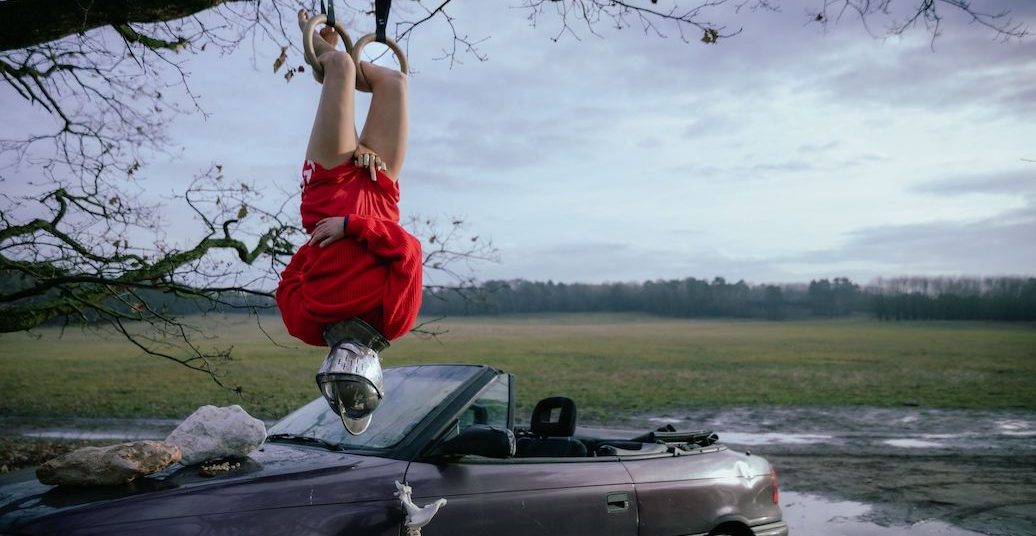Claire Vivianne Sobottke’s new work “à mort — A choreographic song cycle for three voices,” running from March 22 – 25 2023 at Sophiensæle, is a conglomeration of countless musical, physical, stage and costume design details, behind which lies an impressive ensemble performance. The piece recounts explicitly and with relish the futility of every attempt to contain the female naked body.
The floor is covered in a brown carpet, gymnastic rings hang from the ceiling, a climbing tree cobbled together out of wooden boards and two big papier-mâché stones stand on the stage, and individual body parts and bones are scattered everywhere (space/objects: Clementine Pohl, Yoav Admoni). Three naked women, all with long hair, scramble on all fours across the barren landscape, interacting in a way that feels distinctly non-human (performance/development: Moss Beynon Juckes, Stina Fors, Claire Vivianne Sobottke). Entering the Sophiensæle theatre, you feel a bit as if you have found yourself in an enclosure of peaceful predators. Then, after the audience is seated, a song begins: a song about pain and broken hearts, about regeneration, patching oneself up, and starting over again. This beginning anticipates the cyclical structure named in the title of Claire Vivianne Sobottke’s new work “à mort — A choreographic song cycle for three voices.” Each of the four chapters of the piece is also a new and sensual approach to shamelessness.
The first chapter is announced as Chapter one: remember that you must die. The animals turn into humans who, laughing in every possible intonation, become aware of their mortality. As they roll here and there and over one another, they playfully brush up against madness. The silicone hands strewn around the space then appear to seize the performers, one after another—suddenly the hands are stuck into mouths, peering out between legs, or wriggling around in hair. A surreal tangle of bodies is formed with scurrying hybrid hands whose material (synthetic or flesh?) soon becomes indistinguishable. The teeming limbs and cackling laughter are intensified by the strobe-like flickering of the light and the wailing music, until the entire space is filled with the vibrations of hyper-aliveness in the face of death.
When Chapter two: the wild boys begins, the performers put on clothes; they’re unrecognizable. The three young boys do not leave out a single gesture of male dominance. They piss, smoke, climb, and the whole time come across as so ridiculous that it is impossible to take any of it seriously. Then one of them intones a variation of Schubert’s Winterreise, taking the performance of sadness as a completely empty, purely aesthetic gesture to the extreme. And before you can decide whether this variety of masculine posturing, primarily made up of attempts, failures, and games, is in fact threatening or harmless, the performers once again relieve themselves of clothes and manhood. This constant dressing and undressing constitutes the dramaturgical skeleton of “à mort.” The repeated wrapping and unwrapping of the bodies infuses the piece with a basic eroticism; it ensures that you never really get used to the nakedness of the bodies on the stage.
Chapter three: how to kill an animal next stages a grotesque hunting scene in which a naked hunter works themselves into an increasingly erotic frenzy of dominance over their just-as-naked prey. The dynamics that emerge (the exoticization of the still-living quarry, the pleasure of the hunt, and the total disinterest in the prey coupled with self-glorification for the act) call up associations to pickup artists who approach the objects of their desire in a similarly theatrical and violent manner. In the final chapter, female desire is fully freed from its cage. Set to the evocative sounds of hunting horns and string instruments (musicians: Abigail Sanders, Elena Kakaliagou) and electronic samples (composition/music: Stellan Veloce, Kaj Duncan David), a kind of ritualistic exorcism is carried out, in which two of the performers fly through the air on the gymnastic rings while the third sits on a tractor, accompanying the symphony with death metal growls. This could well be the unfolding of the patriarchy’s literal nightmare. Nevertheless, when it comes to shame(lessness) in the matter of one’s own female body, there is always a new battle to be fought in the war—and so, in the end, naked bodies roll across the stage once more.
English translation by Cory Tamler
“à mort” — A choreographic song cycle for three voices by Claire Vivianne Sobottke (premiere: 22.03.2023) can be seen at the Sophiensælen until 25.03.2023, tickets under sophiensaele.com.
Choreography/Concept/Performance: Claire Vivianne Sobottke – Composition/Music: Stellan Veloce, Kaj Duncan David – Musical Cooperation/French Horn: Abigail Sanders, Elena Kakaliagou – By/with: Moss Beynon Juckes, Stina Fors, Claire Vivianne Sobottke – Space/Objects: Clementine Pohl, Yoav Admoni – Lighting Design/Technical Direction: Catalina Fernandez – Costume: Lea Kieffer – Dramaturgical Advice: Mila Pavićević – Outside Eyes: Sheena McGrandles, Maria Scaroni – Artistic Production Direction: Simone Maria Graf.




